The Face recognition analytics type. View and edit
View a case
To view an analytics case of the Face recognition analytics type, you can choose between table and tile display modes. Tile display mode is set as the default.
In table mode, additional possible matches for the recognized object are displayed.
In tile mode, only the highest percentage matches with the reference image are shown.
Both tile and table display modes allow you to set the number of items displayed per page (15, 25, 50, and 100).
To switch display modes, select the corresponding button.
.png?inst-v=c246fb15-1530-4ba8-b650-c220381b36ae)
View modes
Table display mode
In table mode, the following columns are displayed:
Event image. Two images are displayed – the image captured by the camera and the reference image. Select an image to view it full screen.
Event name. Displays one of the following values:
Face recognized
Face unrecognized
Resource name/group. Displays the name of the resource that serves as the reference image and the name of the group in which the resource is stored.
Camera. Displays the camera name that captured the event. Selecting the camera name navigates you to the archived moment of the event.
Similarity %. The matching percentage of the reference and captured images. The color code depends on the value:
0-20 – red
21-99 – orange
100 – green
Created. The date and time of the event.
The Plus icon to add the resulting image to the resource group as a reference image.
.png?inst-v=c246fb15-1530-4ba8-b650-c220381b36ae)
Table mode
Tile display mode
In tile mode, each event contains the following information:
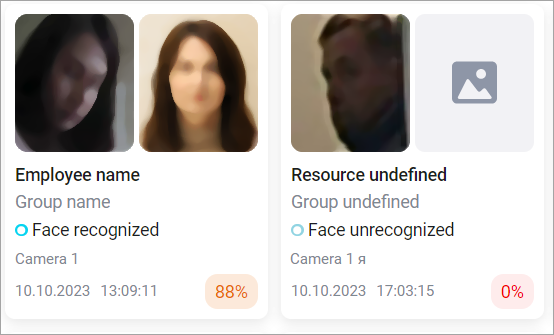
Tile display mode
Two images: the image captured by the camera and the reference image. Select an image to view it full screen.
The name of the resource that serves as the reference image.
The name of the group in which the resource is stored.
An event name.
A camera name that captured the event. Selecting the camera name navigates you to the archived moment of the event.
A date and time of the event.
The matching percentage of the reference and captured images. The color code depends on the value:
0-20 – red
21-99 – orange
100 – green
When you hover over an event, a button for adding the resulting image as a reference image is displayed.
Add an image as a reference
You can add an image captured by the camera to a resource group and set this image as a reference one.
To do this, select the Add button.
.png?inst-v=c246fb15-1530-4ba8-b650-c220381b36ae)
The Add button
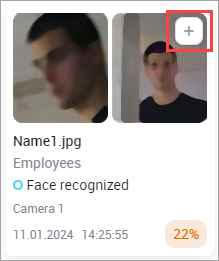
The Add button in tile mode
Next, complete a form.
Specify which resource group the image should be placed in. Choose group and select a group from the list. You can also create a new resource group. To do this, select Create group and enter the name of the group.
To save the changes, select Save resource.
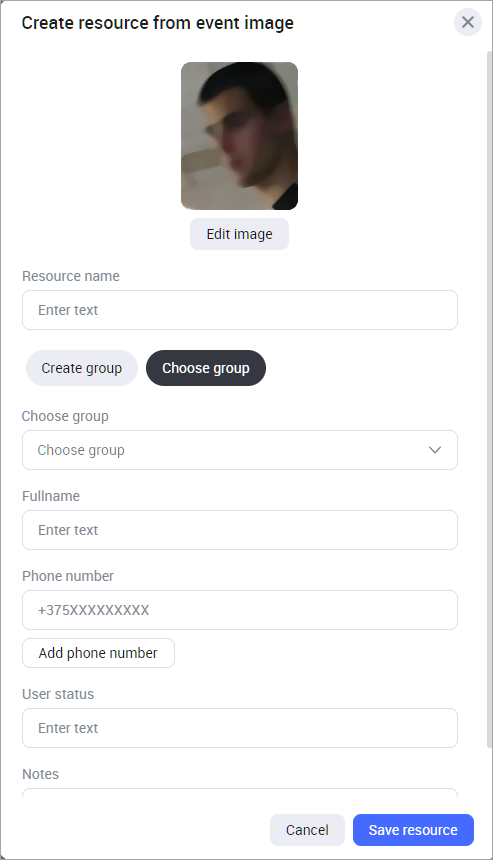
Adding an image as a reference
Filters
You can filter the information to be displayed with the following filters:

The filters
Selecting a camera or multiple cameras will filter the events captured by these cameras.
Setting a specific time period will filter the events captured within the specified period.
Selecting a group or multiple groups will filter the events in which the selected resource groups were used for facial recognition.
Selecting resources will filter the events in which the selected resources were used for matching.
Selecting the specific events will filter only the relevant events: Face recognized, Face unrecognized.
Setting the Similarity values will filter the events with a relevant percentage match of the captured image with the reference.
Select an image to view it full screen.
Both the camera image and the analytics resource image will be displayed.
The Similarity filter is helpful when there are multiple possible matches for the recognized object. You can specify only lower or upper limit (with a value not exceeding 100%).
You can access the camera archive by selecting a camera name in any display mode.
Edit a case
To edit a case, select the Settings button when viewing an analytics case.
Introduce all necessary changes and select Save to save the changes.
You can edit all the previously specified settings, except for changing the analytics type in step 1.
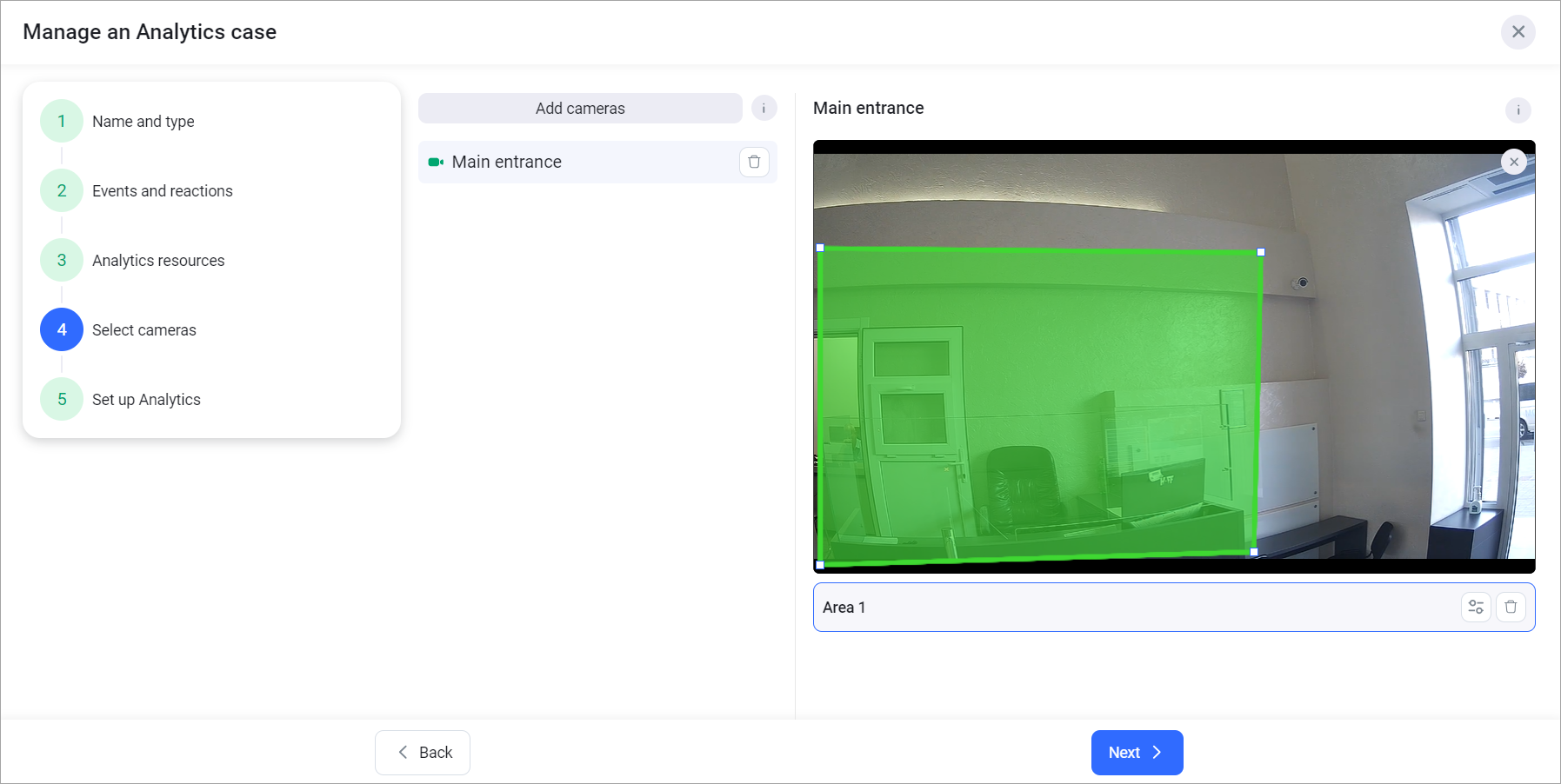
Editing the case with the Face recognition analytics type
When managing a case, you decide to remove a camera with recorded events, then choose a specific method for the camera’s deletion.
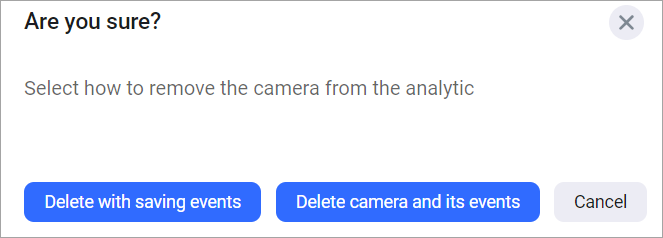
Deleting the camera
Delete camera with saving events.
Delete camera and its events.
As a result of selecting the Delete with saving events option, all the events that were associated with this camera will be displayed in the analytics case. These events will be taken into account in a generated report, when displaying the list of events. It will be possible to navigate and view the archived event from the list of events.
If you select the Delete camera and its events option, all events that were associated with this camera will be completely deleted.
Generate a report
To generate a report, select the Generate report button.
Complete the opened form and select Submit.
.png?inst-v=c246fb15-1530-4ba8-b650-c220381b36ae)
Generating a report
When the report is ready, you’ll see a notification with a link to download it to your device. Select the link, and the report will be downloaded in an Excel file.
.png?inst-v=c246fb15-1530-4ba8-b650-c220381b36ae)
An example of a generated report
Stream settings
Selecting the Stream settings button opens the Analytics case status panel that contains additional information about the current case and its cameras.

The Analytics case status
The following details are available for each camera added to the case:
A status of an analytics stream. When the analytics stream status is Active, the Pause button will be available.
An Analytics stream ID.
At the left bottom, you can find the status of the analytics case. You can pause an Active analytics case. As a result, all active analytics case streams of all the cameras of this case will be paused as well.
You can report issues on each or all the streams to the support team.
To report an issue on a specific stream:
Select Complain on steam of the relevant stream.
On the opened from, select the complaint reason:
Analytics events do not arrive. Analytics stream is inactive.
Analytics events do not arrive. Analytics stream is active.
.png?inst-v=c246fb15-1530-4ba8-b650-c220381b36ae)
Complete the form
Select Complain.
As a result, the complaint will be forwarded to the support team.
To report an issue for all the available streams:
On the Analytics case status panel, select Complain on all streams.
On the opened from, select the complaint reason:
Analytics events do not arrive. Analytics stream is inactive.
Analytics events do not arrive. Analytics stream is active.
.png?inst-v=c246fb15-1530-4ba8-b650-c220381b36ae)
Select the reason
Select Complain.
